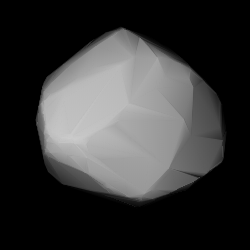Astronomy:206 Hersilia
From HandWiki
Short description: Asteroid
 3D convex shape model of 206 Hersilia | |
| Discovery | |
|---|---|
| Discovered by | C. H. F. Peters |
| Discovery date | 13 October 1879 |
| Designations | |
| (206) Hersilia | |
| Pronunciation | /hərˈsɪliə/[1] |
| Named after | Hersilia |
| A879 TC, 1961 WG 1974 PM | |
| Minor planet category | Main belt |
| Orbital characteristics[2] | |
| Epoch 31 July 2016 (JD 2457600.5) | |
| Uncertainty parameter 0 | |
| Observation arc | 136.34 yr (49798 d) |
| |{{{apsis}}}|helion}} | 2.84299 astronomical unit|AU (425.305 Gm) |
| |{{{apsis}}}|helion}} | 2.63811 AU (394.656 Gm) |
| 2.74055 AU (409.980 Gm) | |
| Eccentricity | 0.037379 |
| Orbital period | 4.54 yr (1657.1 d) |
| Average Orbital speed | 17.99 km/s |
| Mean anomaly | 348.975° |
| Mean motion | 0° 13m 2.078s / day |
| Inclination | 3.77868° |
| Longitude of ascending node | 145.169° |
| 299.705° | |
| Physical characteristics | |
| Dimensions | 113 km |
| Rotation period | 11.122 h (0.4634 d) |
| Geometric albedo | 0.055 |
| Physics | unknown |
| C | |
| Absolute magnitude (H) | 8.68 |
Hersilia (minor planet designation: 206 Hersilia) is a fairly large Main belt asteroid. It was discovered by C. H. F. Peters on October 13, 1879, in Clinton, New York. The asteroid was named after Hersilia, Roman wife of Romulus. It is classified as a primitive, dark carbon-rich C-type asteroid.
Measurements made with the IRAS observatory give a diameter of 101.72 ± 5.18 km and a geometric albedo of 0.06 ± 0.01. By comparison, the MIPS photometer on the Spitzer Space Telescope gives a diameter of 97.99 ± 7.40 km and a geometric albedo of 0.06 ± 0.02.[3]
The last close earth transit was in November and December 2002.
References
- ↑ Noah Webster (1884) A Practical Dictionary of the English Language
- ↑ "206 Hersilia". JPL Small-Body Database. NASA/Jet Propulsion Laboratory. https://ssd.jpl.nasa.gov/sbdb.cgi?sstr=206;cad=1.
- ↑ Ryan, Erin Lee; et al. (April 2012), "The Kilometer-Sized Main Belt Asteroid Population as Revealed by Spitzer", arXiv:1204.1116 [astro-ph.EP]
External links
- The Asteroid Orbital Elements Database
- Asteroid Lightcurve Parameters
- Asteroid Albedo Compilation
- 206 Hersilia at AstDyS-2, Asteroids—Dynamic Site
- 206 Hersilia at the JPL Small-Body Database
 |

